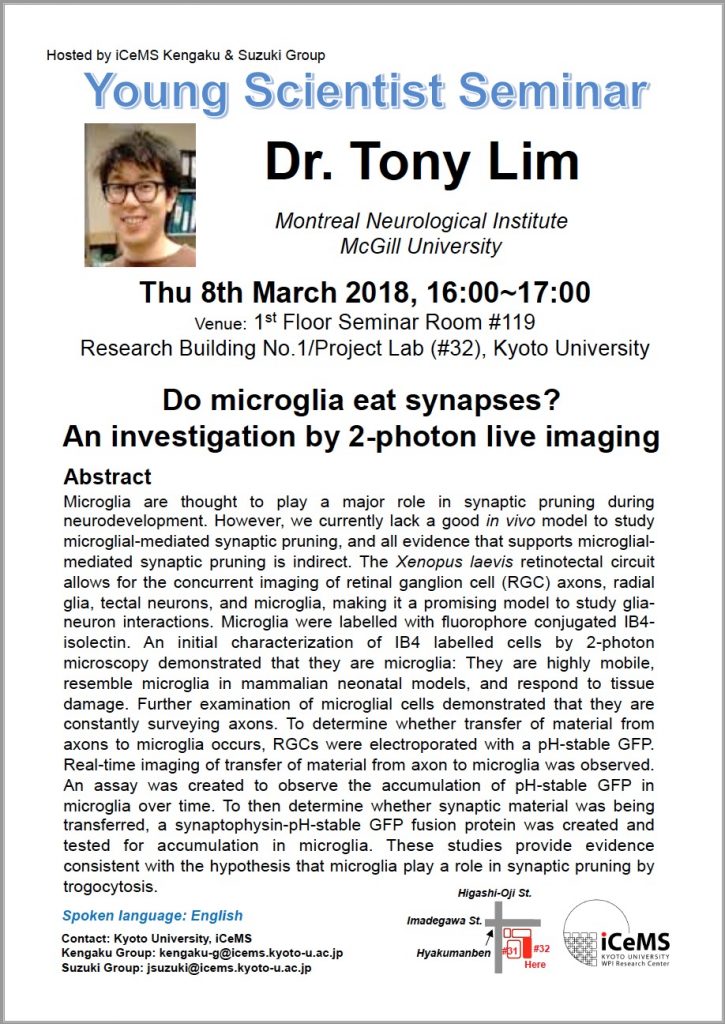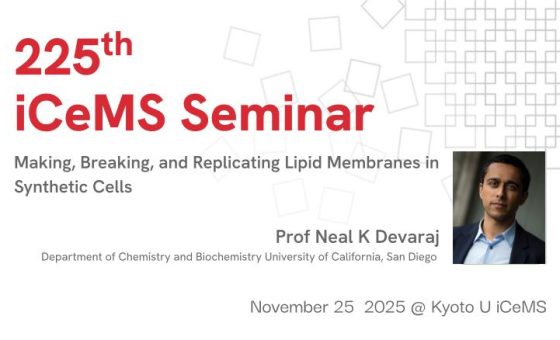iCeMS見学 & 鈴木グループセミナー:Tony Lim 博士

このたび、高等研究院物質-細胞統合システム拠点 (iCeMS) 見学グループと鈴木グループは、セミナーを以下の通り共催いたします。
事前申し込みは不要ですので、皆様のご参加をお待ちしております。
Tony Lim 博士
Post-doc Fellow, Montreal Neurological Institute, McGill University
Do microglia eat synapses? An investigation by 2-photon live imaging
Microglia are thought to play a major role in synaptic pruning during neurodevelopment. However, we currently lack a good in vivo model to study microglial-mediated synaptic pruning, and all evidence that supports microglial-mediated synaptic pruning is indirect. The Xenopus laevis retinotectal circuit allows for the concurrent imaging of retinal ganglion cell (RGC) axons, radial glia, tectal neurons, and microglia, making it a promising model to study glia-neuron interactions. Microglia were labelled with fluorophore conjugated IB4-isolectin. An initial characterization of IB4 labelled cells by 2-photon microscopy demonstrated that they are microglia: They are highly mobile, resemble microglia in mammalian neonatal models, and respond to tissue damage. Further examination of microglial cells demonstrated that they are constantly surveying axons. To determine whether transfer of material from axons to microglia occurs, RGCs were electroporated with a pH-stable GFP. Real-time imaging of transfer of material from axon to microglia was observed. An assay was created to observe the accumulation of pH-stable GFP in microglia over time. To then determine whether synaptic material was being transferred, a synaptophysin-pH-stable GFP fusion protein was created and tested for accumulation in microglia. These studies provide evidence consistent with the hypothesis that microglia play a role in synaptic pruning by trogocytosis.
- 日時
- 2018年3月8日(木)16:00〜17:00
- 場所
- 京都大学 本部構内総合研究1号館/プロジェクトラボ(建物番号 32)1階 119号
- 事前登録
- 必要なし
- 言語
- 英語
- 主催・問い合わせ
-
京都大学 高等研究院 物質-細胞統合システム拠点(iCeMS)
見学美根子グループ:kengaku-g [at] icems.kyoto-u.ac.jp
鈴木淳グループ:jsuzuki-g [at] icems.kyoto-u.ac.jp
-560x340.jpg)






